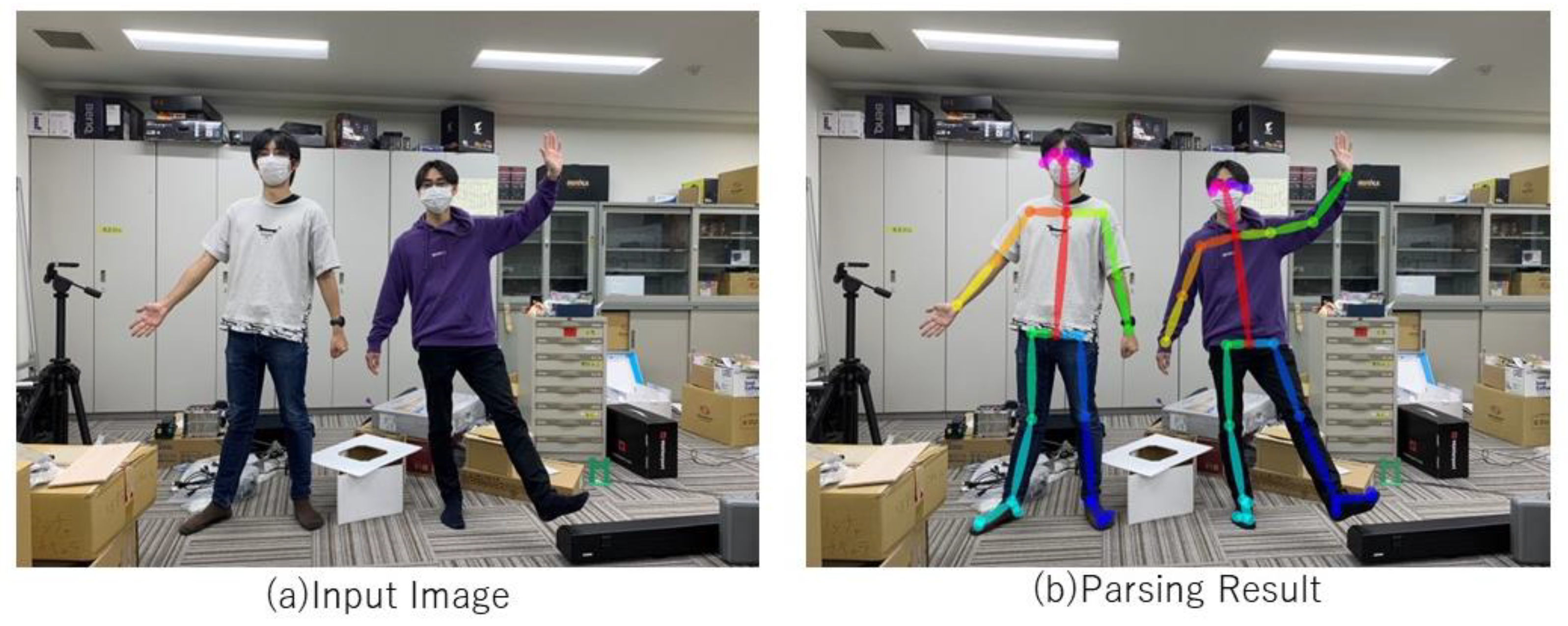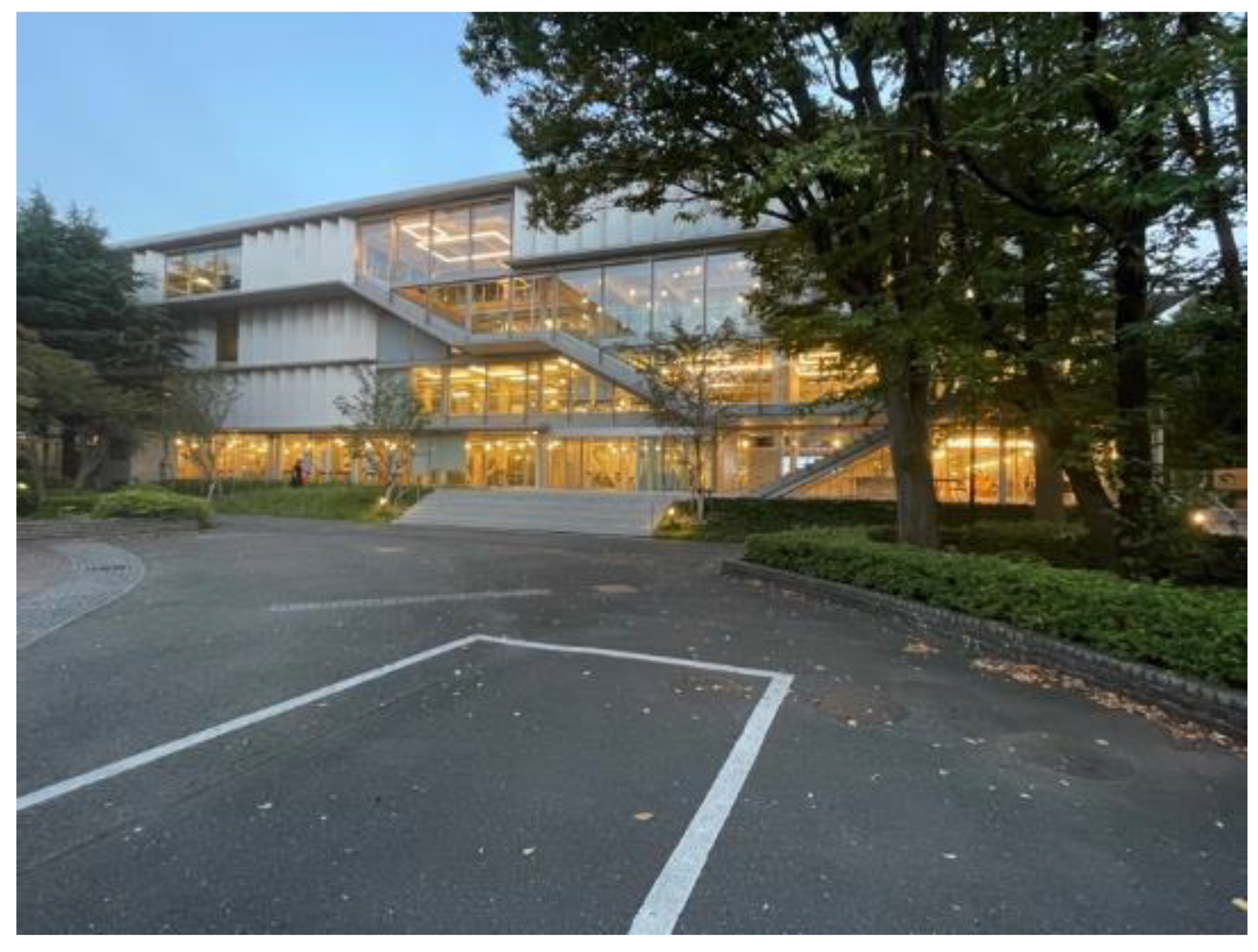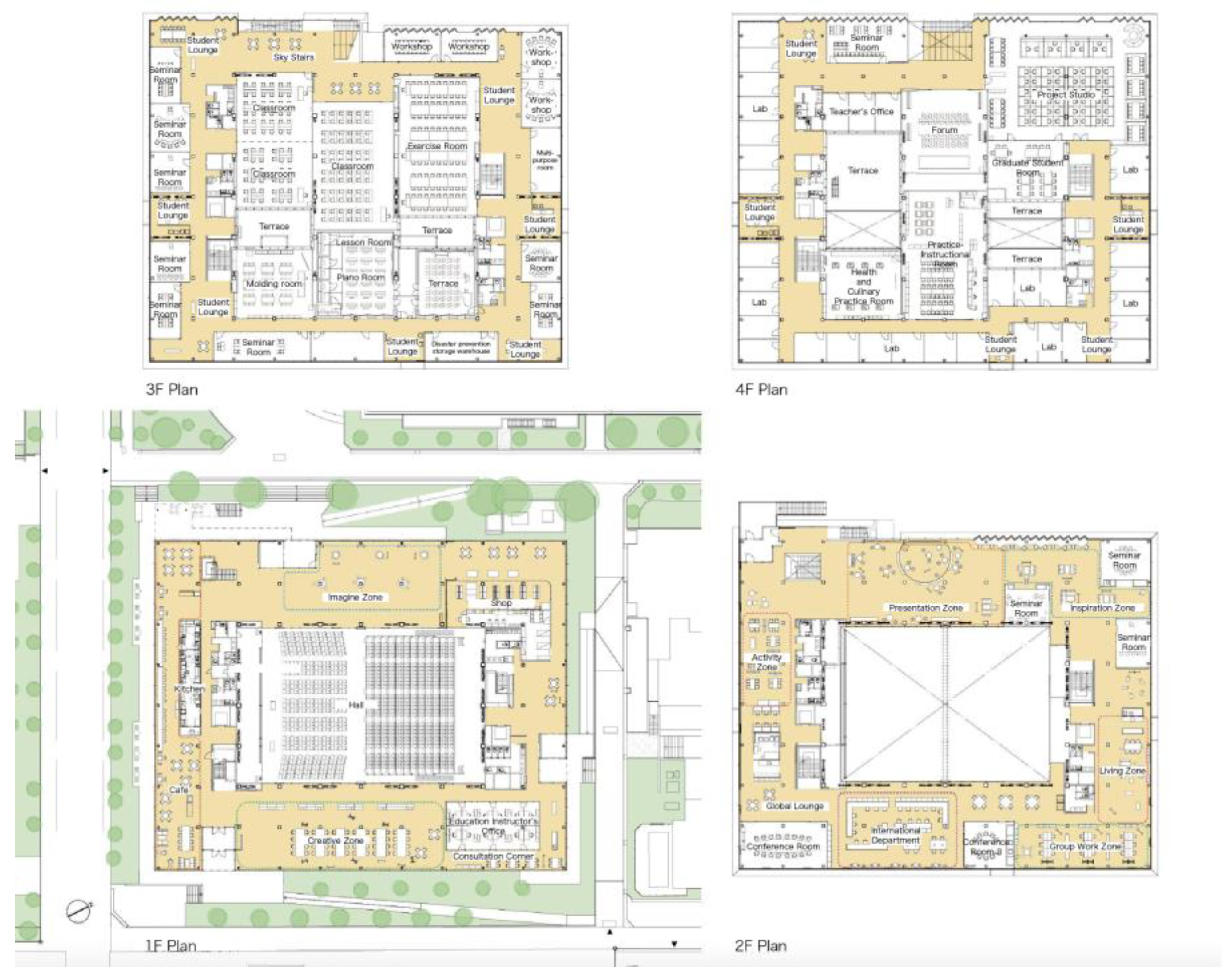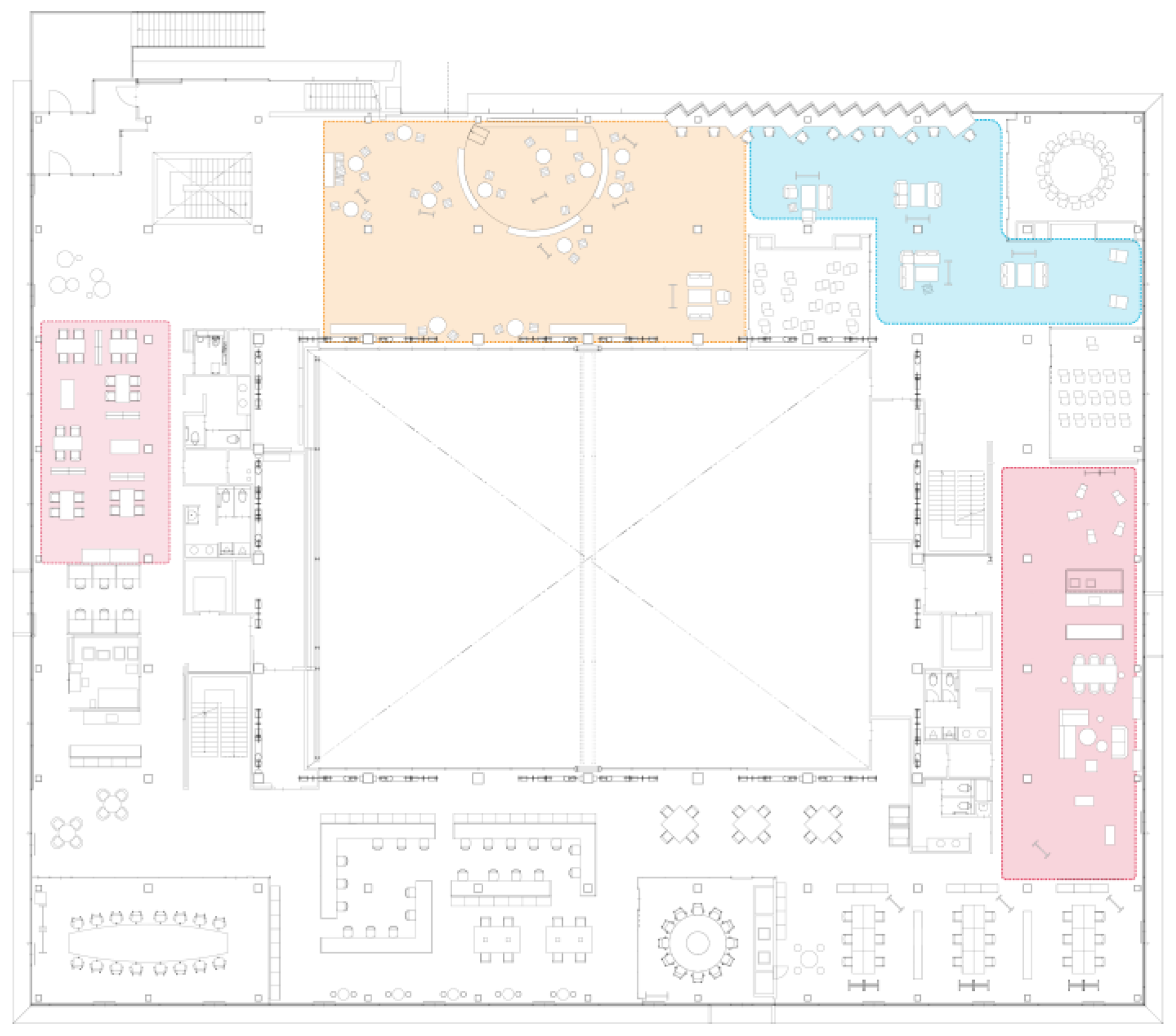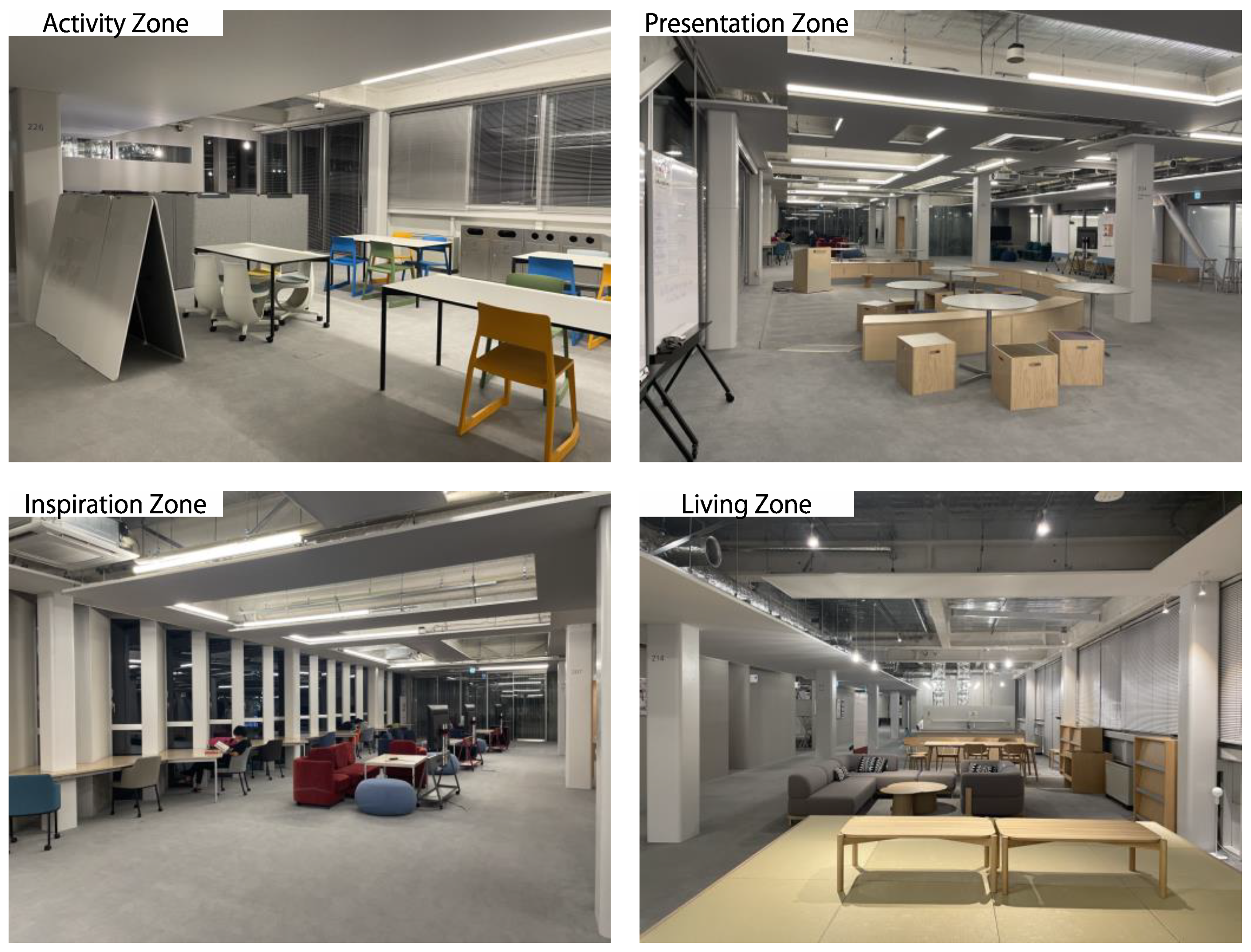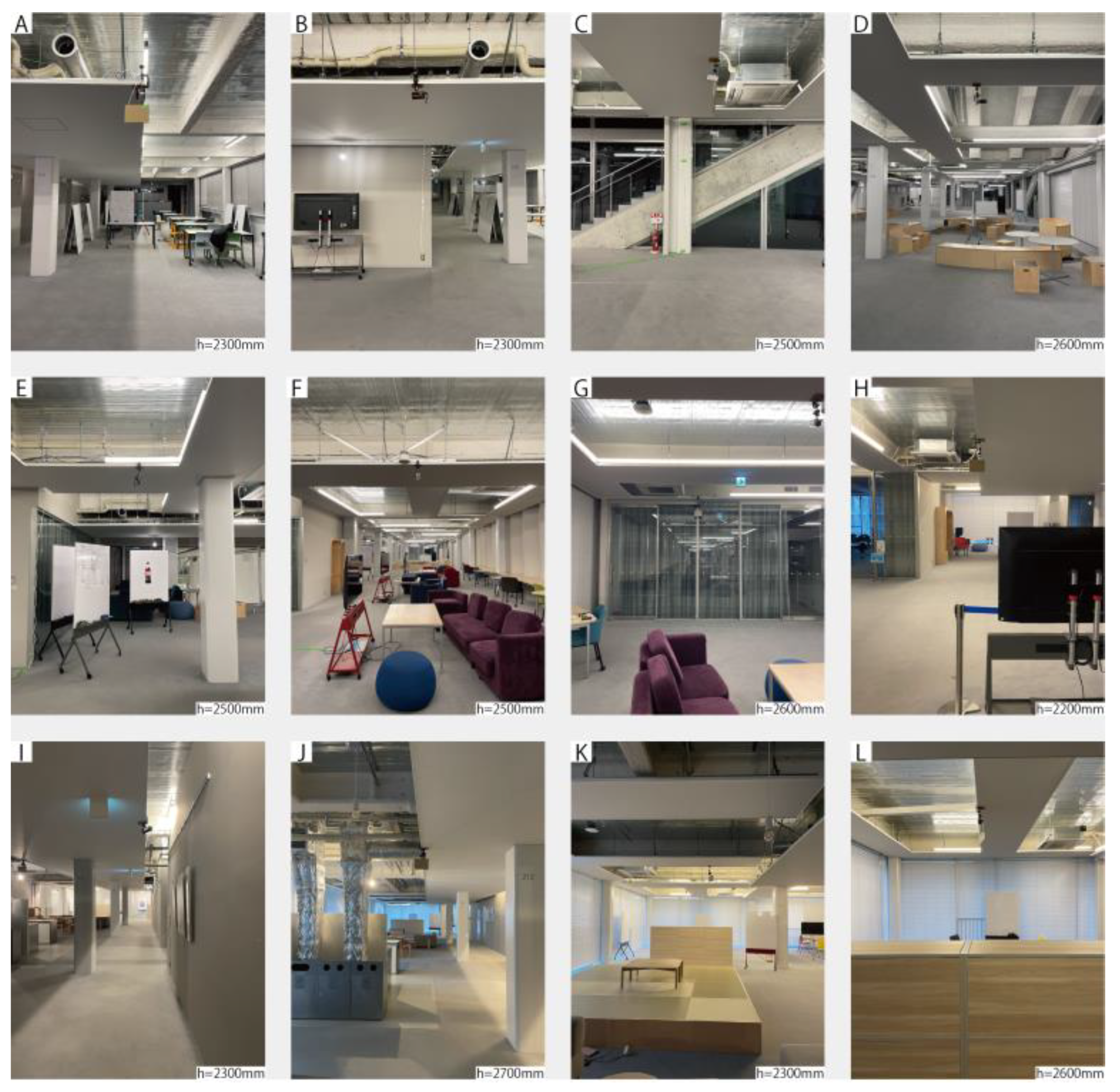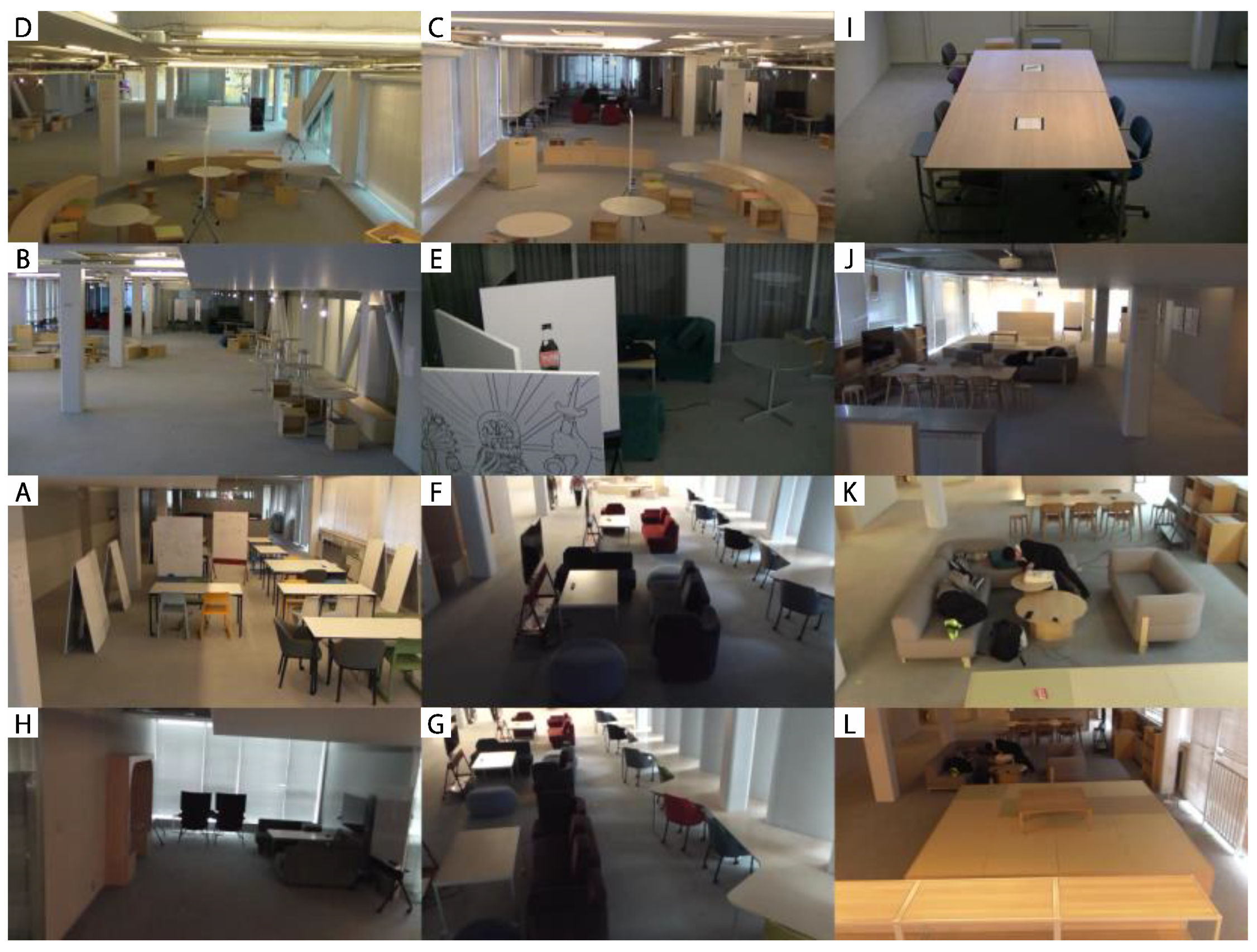1. Introduction
Today, architecture not only serves its purpose but also extends to encompass the spaces where people leisurely spend their free time, emphasizing the significance of user activities [
1]. Efforts have been made to introduce virtual human walking scale models for 3D architectural models within actual spaces, aiming to incorporate these movements into architectural design [
2]. This is an example of an effort to bring diverse meanings to a single space by incorporating user activities into architectural design. Through the incorporation of anthropological elements into architectural studies, we can read the trends of SDGs proposed today [
3]. Such a long-term, multifaceted perspective is manifested in architecture as “common areas”. Furthermore, these spaces are composed of a few elements and are characterized by their operability [
4]. However, this operability is demonstrated from the administrator’s perspective, which differs from the contemporary goal of achieving diversity. This is natural in the context of modern architectural construction methods proposed for building administrators. However, the freedom offered by the lack of elements that improve operability on the part of administrators may be inconvenient to users [
5]. Consequently, we surmise managers need to continually enhance their software, such as events and services, to meet evolving user needs.
Regarding existing research exploring human activities with furniture and spatial arrangements, noteworthy articles include “A Study on the Combination Shape and Arrangement of Furniture in Rooms and User Behavior: A Case Study of the Kagoshima University Library Learning Commons” [
6] and “A Study on Common Space in Campus Architecture: Usage Factors Based on Furniture Arrangement in Flow Line Space” [
7].
The article titled “Research on the combined shape and arrangement of furniture and user behavior in a room–on the Learning Commons in the Kagoshima University Library” focuses on the learning commons situated within the Kagoshima University Central Library. Through a visual observation survey, the study juxtaposes “user information” with “constituent information” to scrutinize the relationship between user behaviors and the distinctive furniture and other items shaping the space [
6].
The article titled “A Study on Common Spaces in Campus Architecture from the Viewpoint of Furniture Arrangement in Flow Line Spaces” examines Utsunomiya University Building No. 11. Through questionnaires and activity surveys, the study investigates the relationship between users and furniture arrangement, with various configurations of movable furniture [
7].
Both studies investigated how people interact with movable furniture within their environments and clarified the relationship between furniture and human activities. However, relying solely on activity surveys and questionnaires to obtain results might yield disjointed and incomplete insights into the spatial dynamics.
This study aimed to conduct a continuous and extensive survey using video cameras. Furthermore, using techniques such as “Open Pose” enables the objective evaluation of human activity by generating a detailed stance distribution.
To address these issues, this study examines how users shape their environment by observing them through video cameras. It considers the ongoing and varied behavior of users as they proactively influence the space. In architectural spaces characterized by the simultaneous occurrence of multiple user activities and their interplay, using video cameras for research becomes crucial as they enable continuous and extensive data collection. Furthermore, video camera research eliminates the need for a researcher to be physically present on site, minimizing disruption to space users and allowing data collection in a space that retains its usual atmosphere.
Furthermore, the potential for objective evaluation of human activity using “Open Pose” to create distribution of people’s presence in specific locations will be explored. Surveying a single space extensively requires considerable time and requires loading user data. Therefore, such spaces are typically selected and surveyed intermittently, introducing a significant subjective component into the process. “Open pose” offers the advantage of displaying a vast amount of time and user data for a space in the form of a distribution map without compromising objectivity. This objective evaluation of the anthropological component, user activity, will help demonstrate the reciprocal influences between anthropology and architecture.
2. Materials and Methods
In the common areas on the university campus, several movable furniture pieces are available for users. Video cameras are used to record user’s proactive use of such furniture. These cameras use a standard RGB camera to capture images. The video camera images were used to depict the arrangement of furniture in the morning and in the evening from a plan view, noting any changes in furniture positions. Furniture transfigurations showing signs of active use were selected, and the process and results of these transfigurations were recorded and discussed using video footage. A flowchart outlining the proposed method is shown in
Figure 1.
Additionally, the distribution of people staying in the space is created using “Open Pose” with the aim of visualizing people’s activities within the space.
To represent the results in the plan view, the posture estimation algorithm named “Open Pose” was used to detect persons from the video images captured by the video camera. Using the data obtained, a perspective projection transformation was used to reflect these results in the plan view.
Based on the data recorded using the video camera, posture estimation is performed using “Open Pose”. As shown in
Figure 2, posture estimation using Open Pose is a type of image recognition method that detects the co-ordinate data of feature points, such as joints, eyes, and nose, on the human body, and visualizes human posture based on this information. In recent years, posture estimation techniques have found applications in diverse fields such as manufacturing, sports, and entertainment, leading to the exploration of various approaches [
8,
9,
10]. Additionally, in the field of architecture, posture estimation has been used to design comfortable living spaces by analyzing human behavior [
11,
12].
Additionally, “Open Pose” is a posture estimation algorithm introduced by Zhe Cao et al. at Carnegie Mellon University. This algorithm uses deep learning to detect the joints in a person and combines this data to perform posture estimation. Therefore, rather than detecting entire people, Open Pose focuses solely on estimating a person’s joints and uses the direction vectors of the joints to accurately combine them. Consequently, it is considered as a highly accurate tool for pose estimation, particularly for estimating unspecified persons [
13].
Since the 3D coordinates of the camera in the world coordinate system, as defined with respect to the columns in the common areas of the university campus, are known (as shown in
Figure 3), the positions of people and furniture on the floor captured by the overhead camera do not align with their actual spatial positions. However, they can be adjusted using perspective projection transformation [
14]. The blue dots in
Figure 3 indicate the range to be tracked before and after the transformation, while the red dots represent the trajectory of the person to be tracked.
Once the
x-coordinates and
y-coordinates of the person and furniture in the world coordinate system are obtained from the camera, their real-space positions (
u and
v) can be determined using Equation (1) with a homogeneous transformation matrix. This matrix consist of external parameters, translation (
t) and rotation (
r)—and the internal parameters— focal length (
f) and image center (
c)—as shown below.
Here, the average positions of the person’s right and left feet estimated using “Open Pose” are used as the person’s position in the camera image to accurately determine their position in space. This position is then reflected onto the plan view by perspective projection transformation.
3. Results
3.1. Experiment
3.1.1. Experimental Facility
This study focused on Building No. 7 of the Setagaya Campus of Tokyo City University. The facility used in the experiment is illustrated in
Figure 4.
Tokyo City University Building No. 7 is a university facility comprising halls and classrooms located on Tokyo City University’s Setagaya Campus. Planned for a site area of 23,290.86
, the building boasts a building area of 2875.52
and a total floor area of 10,105.03
. It stands as a four-story steel frame building, designed as a complex facility intended to accommodate the Faculty of Urban Life Studies and the Faculty of Human Sciences at Tokyo City University. In addition to the halls and classrooms, Building No. 7 also includes special classrooms such as cooking rooms, piano rooms, and molding rooms. These facilities serve as bases for the Faculty of Urban Life Studies and the Faculty of Human Sciences [
15].
Figure 5 shows the floor plan for Building No. 7 on the Setagaya Campus of Tokyo City University.
Figure 5 shows that Tokyo City University Building No. 7 is characterized by the inclusion of common areas in addition to halls and classrooms. The 1F area is centered around the TCU Hall, which is surrounded by a café and a creative zone. Similarly, on the second floor, common areas are situated along the corridor around the atrium of the TCU Hall. The 2F area features distinctive common areas such as presentation areas and living rooms. While the third and fourth floors primarily house classrooms and laboratories, several student lounges are planned between the rooms.
3.1.2. Experimental Environment
The experimental area was a common space on the second floor of Building No. 7 on the Setagaya Campus of Tokyo City University. The experiment was conducted in designated areas called the activity zone (pink), presentation zone (orange), inspiration zone (light blue), and living room (red) (
Figure 6). These communal areas were designed to encourage individual and small-group activities, such as group work, report writing, and online classes, in which students engage autonomously as well as in collaboration with others, fostering communication and cooperation. Based on this design, the space was constructed to be open and fluid, featuring interior furniture and glass partitions [
15]. These four sites were selected for the experiment due to their anticipated facilitation of more small-group activities, such as group work, report writing, and online classes, as described earlier.
Figure 6 shows the experimental area for the Setagaya Campus Activity at Tokyo City University, along with the initial furniture arrangement plan for the area.
Each zone of Building No. 7 on the Setagaya Campus of Tokyo City University features a distinct furniture arrangement. In the activity zone, tables and chairs that can be moved by users are arranged. In the presentation zone, a circular plaza with dice-shaped stools was placed one step lower. Sofa seats were arranged in the inspiration zone, and tatami mats and sofas were arranged in the living zone.
Figure 7 shows the common area on the second floor of Building 7 on the Setagaya Campus of Tokyo City University.
The experiment was conducted on weekdays from 15 December 2023 to 21 December 2023. Because of the busy nature of the university campus, video cameras were used to capture images on five weekdays, excluding Saturdays and Sundays, when user traffic was high. The video camera operated from 10 min before the first period to 10 min after the fifth period, covering the entirety of the day’s lectures. This totaled 10 hours, from 9:10 am to 7:10 pm.
The locations and quantities of models in the video camera are shown in
Figure 8.
Table 1 lists the specifications of the video cameras.
Furthermore, a camera was installed using a clamp-type tripod secured against a panel stretched across the ceiling to prevent interference with users. The power supply for the video camera was obtained from an electrical outlet and connected to the video camera using an extension cord. Additionally, the video camera was connected to the ceiling panel through walls and pillars minimize disruption to users.
Figure 9 shows the position and height of the video camera at each location. Each point from A–L in
Figure 9 corresponds to the points in
Figure 8.
Additionally, the video resolution was compressed to 720 × 480 to decrease the video size for processing.
Table 2 lists the specifications of the personal computers used in the process.
3.1.3. Video Editing for Visual Clarity
The video footage from the 12 locations for one day was consolidated into a single video by dividing and displaying them on a 4 × 3 grid. The arrangement was determined by the relevance of each location, with the video data from the presentation zone displayed in the upper left 2 × 2 grid and the video data from the activity zone in the lower left grid. The 4 × 1 grid on the right side featured video data of the living zone, aligned vertically to facilitate the visual recognition of each location. The order of the 12 locations is shown in
Figure 10. Furthermore, the videos were synchronized such that the time difference between each location was kept within 2 min. Each of the points from A–L in
Figure 10 corresponds to the points in
Figure 8.
4. Discussion
4.1. Discussion of Visual Results
Further analysis and discussions were conducted on furniture transfiguration. The results showed numerous situations where furniture was adjusted to accommodate varying group sizes.
Figure 11 shows that when a group of eight people uses the room, the furniture arrangement is adjusted accordingly to accommodate the group size. These furniture modifications were consistently made throughout the five-day survey period to suit the number of people in the group.
In contrast, furniture adjustments were observed for comfort purposes. As shown in
Figure 12, the monitor and round sofa were relocated to enhance the comfort level.
As shown in
Figure 13, this change in comfort was not consistently observed but occurred primarily in the morning when there were no other users present. This indicates that furniture was mainly rearranged within a scope that did not invade the areas of other groups.
Thus, territoriality emerges as an important factor in furniture relocation. Furthermore, it is evident that the necessity to adjust furniture in general is not as great as the need to move furniture with the number of people occupying the space.
Moreover, as shown in
Figure 14, furniture displacement is highly influenced by the territorial behavior of individuals or groups. There were numerous instances where the furniture arrangement changed within a specific area. These transfigurations were aimed at expanding territory and establishing a more comfortable place.
Furthermore, as shown in
Figure 15, there is a scenario where a round sofa undergoes transformation due to a change in the group using it, aligning with the shift in the area. Therefore, furniture transformation is closely related to the territorial behavior of the area occupied by individuals or groups.
It is clear that the size and shape of the furniture play a significant role in planning these transfigurations. As shown in
Figure 16, the strategic movement of planned furniture helps shape or expand the space by mediating between other less movable furniture.
Therefore, a furniture plan allows users to proactively handle the furniture itself.
The movement of the round metal tables was also observed in the circular plaza. As shown in
Figure 17, this was the only scenario in which the round metal table was observed to move significantly. Two people moved the table, with one person sitting on the floor as the base point. The stool were then gathered around the table to create the scene. Therefore, it can be seen that having a base point is important for furniture movement.
From the above, it can be seen that in Building No. 7 of the Setagaya Campus of Tokyo City University, the needs and territorial behavior of users are closely interrelated with furniture planning, resulting in dynamic and rich spaces. Within this space, the presence of small and lightweight furniture, along with the flexibility in furniture arrangements, encourage users to take the initiative. The observation of results obtained using the video camera offers insights into user autonomy within the space. By conducting the experiment using a video camera, it was possible to continuously capture people’s activities in the space, enabling a detailed study of users’ spatial formation. Additionally, as it is possible to record user activities simultaneously, the influence of each activity, such as interference from different groups, can be understood.
4.2. Discussion of Singular Activities
During this five-day experiment, five types of idiosyncratic activities were identified, as shown in
Figure 18. We believe that such data were facilitated by the ability to record a space closely resembling typical situations using a video camera. The following are examples of unusual behaviors.
This indicates that users have unrestricted and independent access to the space. We attribute this to the influence of user autonomy, facilitated by the movable furniture, on the overall space. The freedom to rearrange furniture encourages users to engage with the entire space proactively, therefore reducing barriers to entry.
Based on the above, we believe it is important to provide opportunities for users to use spaces that promote their independence in common areas through spatial configurations and movable furniture.
Figure 18.
Unusual behaviors.
Figure 18.
Unusual behaviors.
4.3. Consideration with “Open Pose”
To provide a more objective assessment of human activity, persons were detected using “Open Pose” from the video camera footage, and a stay distribution table was generated. The video cameras were positioned at locations K and L.
As shown in
Figure 19, the distribution of stayers in the living zone revealed a consistent pattern across each day, despite some deviations in the furniture arrangement. The red dots indicate the locations where users stayed.
Figure 19 shows that in the tatami area, the stayers were mainly concentrated near the desk in the center of the room, with their distribution extending towards the sofas. This pattern was evident on 15 December 2023, when the distribution of stayers in the tatami area tended to spread towards the upper left. Given this trend of stayers’ distribution moving towards the sofa area from the tatami area, it can be inferred that the tatami area tends to be used in conjunction with the sofa area.
As shown in
Figure 20, the actual video shows that the area of one group extended beyond the designated furniture type. We can infer that this behavior is influenced by the proximity of the sofa to the tatami area, with the sofa area being open to the tatami, and the establishment of a central base point by the round table. This also validates the accuracy of the “Open Pose” distribution map.
The aforementioned results show that “Open Pose” can automatically obtain objective data for a long-term experiment using a video camera, facilitating straightforward discussion and analysis based on this data.
5. Conclusions
In contemporary architectural design, the anthropological component–the activity of the user–is important. This trend is essential for designing multi-layered spaces and introducing diversity into a single space. It is particularly evident in the planning of common areas, with many designs prioritizing the free behavior of users in these areas. In such spaces, it is important to consider the architectural elements that influence user behavior and to create spaces that accommodate various activities. Therefore, studying the current space and evaluating it objectively are necessary steps.
Previous studies have considered people’s characteristics regarding movable furniture and their spaces, elucidating the relationship between furniture and people’s activities. However, the results obtained are discontinuous because of the use of activity surveys and questionnaires, rendering them insufficient for comprehensively understanding the entire space.
In this study, we conducted an experiment using video cameras to clarify the relationship between space and human activity. The use of a video camera allowed us to conduct a continuous and extensive experiment compared to previous studies. Furthermore, the use of a video camera offers the advantage of conducting the experiment in a space similar to a normal situation, where research is not being conducted. We consider these points important in the study of architectural spaces.
From the results, we were able to understand the relationship between architecture and people’s activities and gain insight into the formation of user subjectivity through movable furniture. Users acquire subjectivity by using a significant amount of movable furniture. Within this space, users have the freedom to rearrange movable furniture to create the desired space, accommodating the size of their group and their comfort preferences. Through the use of numerous movable pieces of furniture, users have achieved independence.
Additionally, this study documented behaviors that might be avoided in a typical common area, such as playing guitar or sitting on the floor. These activities indicate that users can utilize the space freely and independently. This suggests that the active engagement with furniture influences the overall use of space. In essence, the freedom to move and use furniture acts as a catalyst, encouraging users to engage with the space or take initiative.
Moreover, the “Open Pose” system was used to detect people and generate a user stay distribution chart by inverting it to a plan view using perspective projection transformation, thereby automatically obtaining objective data. The system’s effectiveness was evaluated by comparing it with actual video images. A drawback of using video cameras is the time-consuming confirmation process. Therefore, we verified the feasibility of processing that can be visually comprehended easily using tools such as “Open Pose”. This was used for a portion of the experiment. In the future, we aim to conduct experiments to comprehensively observe human activities throughout the entire space by using “Open Pose” for all of the video image captured.


